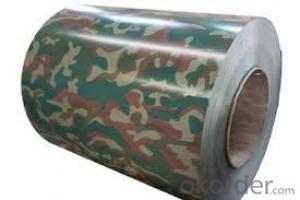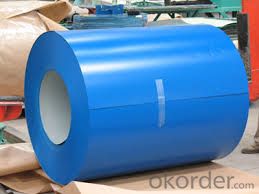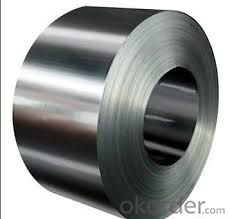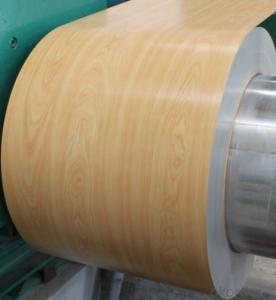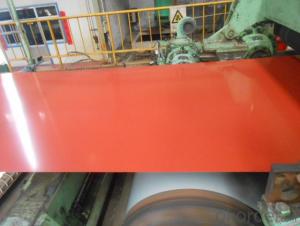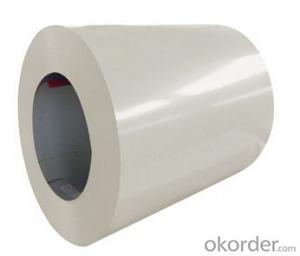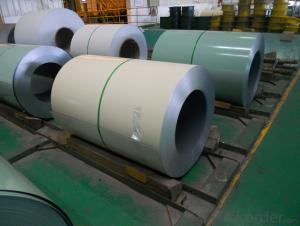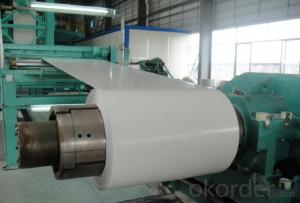Steel Coil /color coated hot rolled steel coil/PPGI Coil
- Loading Port:
- Shanghai
- Payment Terms:
- TT OR LC
- Min Order Qty:
- 30 m.t.
- Supply Capability:
- 10000 m.t./month
OKorder Service Pledge
OKorder Financial Service
You Might Also Like
Quick Details
| Standard: | ASTM,GB,JIS | Grade: | STEEL | Thickness: | 0.18MM-0.8MM |
| Place of Origin: | Zhejiang China (Mainland) | Brand Name: | sukalp | Model Number: | 820 |
| Type: | Steel Coil | Technique: | Cold Rolled | Surface Treatment: | Coated |
| Application: | HOUSE AND BUILDING | Special Use: | High-strength Steel Plate | Width: | 500MM-1600MM |
| Length: | as your request | Zinc coating: | 40-275g/m2 | Coil ID: | 508mm/610mm |
Packaging & Delivery
| Packaging Detail: | export package |
| Delivery Detail: | 15 days after receipt the deposit |
Specifications
Pre-Painted Steel Coil
1)Thinkness of pre-painted steel coil 0.18MM-0.8MM
2)Width of pre-painted steel coil 500MM-1600MM
Pre-Painted Steel coil Features Specifications:
Galvanized steel is hot or cold-rolled strip steel belt of substrates, through continuous hot-dip galvanizin process.It is good in corrosion resistance,high in surface quality, convenient in deep-processing,low cost. Widely used in silo,the fish up , the chimney, kitchen utensil, handicraft, construction formwork, household electrical appliance, roller shutter door, garage door, wave wattand colored substrate,etc.
Product details:
Product | Hot dip galvanized corrugated steel coil/sheet |
material | SGCC,SGCH,SGCE,SPCG,DX51D,Q195,Q235 |
Thickness | 0.13-0.6mm |
Width | 914-1500mm(according to your need) |
Zinc coating | 40-275g/m2 |
Spangle | Regular, small, big or zero |
Coil Weight | 3-8tons |
Capacity | 250,000 tons/year |
Coil ID | 508mm/610mm |
- Q: Can you reload spent casings if they are steel?
- Let me break it down for you. 1) There are two kinds of priming in current use these days -- you cannot tell from the outside which primer it is...only by looking inside the casing. If the casing has a single center primer hole, it is Boxer primed. If the casing has multiple primer holes, none of which is center, it is Berdan primed. Berdan and Boxer are the names of men who designed the priming systems.
- Q: What are the challenges in the production of steel coils?
- The production of steel coils faces several challenges. Firstly, one of the major challenges is ensuring consistent quality throughout the production process. Steel coils need to have uniform thickness, width, and flatness. Achieving this consistently can be challenging due to variations in raw materials, equipment, and operating conditions. Another challenge is managing the high temperatures involved in the production process. Steel coils are produced by heating steel slabs or billets to extremely high temperatures and then rolling them into coils. Maintaining the required temperatures and ensuring proper cooling can be a complex task, as any deviations can lead to inconsistencies in the final product. Furthermore, the production of steel coils requires a significant amount of energy. The steel industry is one of the largest energy consumers globally. Reducing energy consumption while maintaining production efficiency is a constant challenge. Implementing energy-efficient technologies and optimizing processes are necessary to address this challenge. Moreover, the production of steel coils generates a considerable amount of waste and emissions. Steel manufacturing involves various chemical reactions and releases pollutants such as carbon dioxide, sulfur dioxide, and particulate matter. Managing and minimizing these emissions to comply with environmental regulations is a significant challenge for the industry. Additionally, steel coils are often produced in large quantities, requiring efficient logistics and transportation systems. Ensuring timely delivery and minimizing damage during transportation can be a challenge due to the weight and size of the coils. Lastly, the steel industry faces market challenges, including fluctuating prices of raw materials, competition from other materials, and global economic conditions. Adapting to market demands and maintaining competitiveness is crucial for the sustainable production of steel coils. Overall, the challenges in the production of steel coils include maintaining consistent quality, managing high temperatures, reducing energy consumption and emissions, optimizing logistics and transportation, and adapting to market dynamics. Addressing these challenges requires continuous innovation, technological advancements, and a focus on sustainability.
- Q: looking to buy a sashimi knife. what is the difference between white steel (1and2) and blue steel (1and2) in terms on characteristics. what gets sharper? what holds edge longer? basically any info on the pros and cons of each steel would be SO GREATLY APPRECIATED! thanks in advance to all who answer. i'm leaning towards white-2 steel for my first sashimi knife, started training on the sushi bar and need a new tool!
- Blue Steel Knife
- Q: How are steel coils heat treated?
- Steel coils are typically heat treated by subjecting them to controlled heating and cooling processes. This involves heating the coils to a specific temperature, holding them at that temperature for a defined period, and then slowly cooling them. The heat treatment process helps to improve the mechanical properties of the steel, such as its strength and hardness, by altering its microstructure.
- Q: How do steel coils contribute to energy efficiency in transportation?
- Steel coils contribute to energy efficiency in transportation in several ways. Firstly, steel coils are lightweight and have a high strength-to-weight ratio. This means that less steel material is required to carry the same load compared to other materials, such as wood or concrete. As a result, the overall weight of the transport vehicle is reduced, which leads to lower fuel consumption and emissions. Secondly, steel coils are highly durable and can withstand harsh conditions during transportation. They have excellent resistance to corrosion, impact, and fatigue, ensuring a longer lifespan for the transport vehicle. This durability reduces the need for frequent repairs or replacements, resulting in reduced energy consumption and material waste. Furthermore, steel coils are easy to handle and transport. They can be easily loaded and unloaded from trucks, trains, or ships due to their compact and standardized size. This efficiency in handling reduces the time and energy required for loading and unloading operations, thereby increasing overall transportation efficiency. Additionally, steel coils can be efficiently stacked and stored, maximizing the use of available space in transport vehicles. This reduces the number of trips required to transport the same amount of goods, resulting in less energy consumption and lower transportation costs. Lastly, steel is a highly recyclable material. At the end of their life cycle, steel coils can be easily recycled and used to produce new steel products. This reduces the demand for raw materials and the energy required for manufacturing new products, contributing to overall energy efficiency in transportation. In conclusion, steel coils contribute to energy efficiency in transportation through their lightweight, durable, easy-to-handle, and recyclable nature. These characteristics result in reduced fuel consumption, lower emissions, decreased maintenance needs, efficient use of space, and reduced material waste, all leading to a more sustainable and energy-efficient transportation system.
- Q: My musical saw has, despite my best efforts, got little patches of rust on it. How Do I go about removing the rust without spending too much on rust-removal products and without affecting the properties of the steel?
- Steel wool and a bit of WD 40. Steel wool will remove the rust and the WD 40 will protect it in the future.
- Q: How would you calculate the maximum plastic deformation (expansion) a steel pipe can handle before it actually fails?
- You can calculate the maximum reversible strain, for elastic loading as follows: You need to look up the yield strength (for that particular type of steel). Divide this yield strength by the elastic modulus of steel (also called Young's modulus). That gives you the strain at the onset of yielding, the maximum you can strain the steel fibers before crossing the point of no return. If you are interested in the strain until failure, you need to take tensile test measurements. Seldom do people document an equation to model the non-elastic portion of the stress-strain curve of the specimen, because seldom do we design systems to operate with materials which yield. We want systems which only deform reversibly and elastically. This means you need to perform an experiment to find what you are actually desiring to know.
- Q: What is the accuracy of steel tape inspection?
- In addition, the project is through the detection of steel tape, steel tape each batch have the error him different, so do projects each into a batch of steel tape has to go through the inspection department, let this batch of steel tape has reached the same error range. All the measuring tools in this project are unified into these steel tape measures, so that the measurement error is guaranteed
- Q: What are the advantages of using pre-painted steel coils?
- There are several advantages to using pre-painted steel coils. Firstly, pre-painted steel coils have a protective coating applied during the manufacturing process, which makes them resistant to corrosion and increases their lifespan. Additionally, the pre-painted coating provides a smooth and aesthetically appealing finish, eliminating the need for further painting or finishing. This saves time and money on additional coatings or treatments. Moreover, pre-painted steel coils are available in a wide range of colors and finishes, allowing for greater design flexibility and customization. Lastly, pre-painted steel coils are easy to install, lightweight, and have excellent durability, making them an ideal choice for various applications in construction, automotive, and other industries.
- Q: How are steel coils used in the production of metal roofing panels?
- The production of metal roofing panels relies heavily on steel coils, which are rolled sheets of steel. These coils play a crucial role in shaping and forming the panels. To begin, a machine called a roll former is used to unwind and feed the steel coils. This machine gradually shapes and bends the steel into the desired profile of the metal roofing panel using a series of rollers and dies. The coils pass through these rollers, which apply pressure and force to mold the steel into the required shape and size. After the metal has been formed into panels, it may undergo additional processes to enhance its durability and appearance. These processes can include galvanizing or coating the panels with protective layers to prevent corrosion and improve weather resistance. These additional steps ensure that the metal roofing panels can withstand harsh environmental conditions and provide long-lasting performance. Steel coils are chosen over other materials for the production of metal roofing panels because of their strength and durability. Steel has an exceptional strength-to-weight ratio, making it a suitable material for roofing applications. Additionally, steel is highly resistant to various weather conditions such as high winds, heavy rains, and extreme temperatures. This makes it an ideal choice for roofing panels that need to withstand the elements and provide reliable protection for buildings. In conclusion, steel coils are an essential component in the manufacturing process of metal roofing panels. They are used to shape and form the panels, which then undergo further processing to enhance their durability. The use of steel in these panels ensures that they can withstand harsh weather conditions and provide long-lasting performance for residential, commercial, and industrial buildings.
Send your message to us
Steel Coil /color coated hot rolled steel coil/PPGI Coil
- Loading Port:
- Shanghai
- Payment Terms:
- TT OR LC
- Min Order Qty:
- 30 m.t.
- Supply Capability:
- 10000 m.t./month
OKorder Service Pledge
OKorder Financial Service
Similar products
Hot products
Hot Searches
Related keywords
